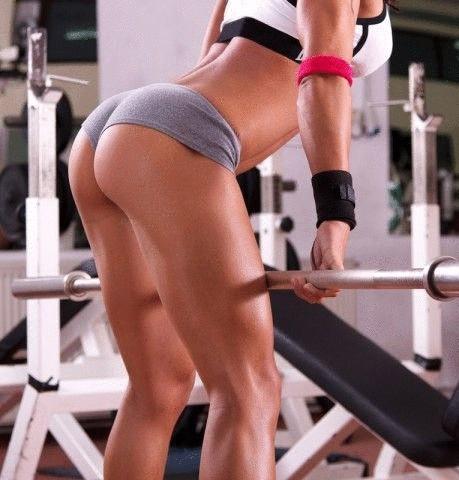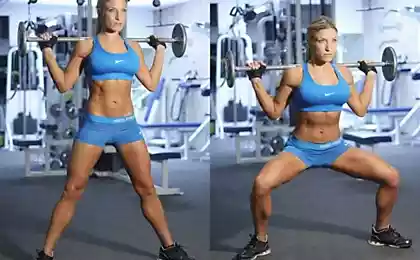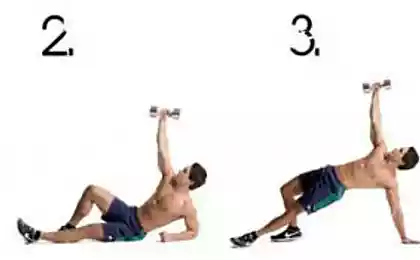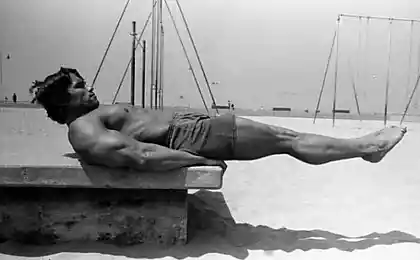500
6 secrets of squats
Eighty nine million seven hundred ninety four thousand nine hundred twenty two
What exercise is a true test of overall strength?
Can bench? Thousand strong warriors of the gyms, I would certainly agree.
What about the dead pull? Many successful strength coaches claim that it is the only real indicator of absolute strength.
However, I believe that the unsurpassed king of exercises are squats, and in any form.
You can accuse me of bias because it is my favorite exercise, but squats are something amazing. Maybe this voltage is mixed with the adrenaline that you get from the comfort of squatting and feeling "a ton" of iron on the back?
Or maybe that indescribable feeling of internal pressure, in which it seems that the eye's bugging out of their sockets, as in one scene of the movie "total Recall" when you are trying to maintain stability and complete the exercise?
Dead pull is great, but if something goes wrong, you can just drop the bar and go home. However, when you reach a dead point in squats, there is only "fight or flight".
Unfortunately, the squat is a complex exercise and there are many things that can cause problems. If you screw up, you can damage the knees or lower back.
While a small deviation from proper technique is the norm at competitions or during attempts to set a personal record, in most cases, you need to adhere to certain rules. So you get the most from squats, while minimizing the risk of injury.
What is a good squat?
There are many forms of squats, but the most effective in terms of developing strength and size are pauerliftingom squats with a moderate or wide of foot. These squats you will use a maximum muscle mass and get great results.
Louie Simmons argues that between squatting with a narrow or broad statement of the feet there is no difference in terms of the activity of the quads, but your hips, glutes and biceps of the thigh are much more effective in wide positions.
The other point is the depth of the squats. To obtain positive effects on muscle size and strength do not have to squeeze the glutes to the calves. Go down as low as I can, main thing keep the correct technique. With the improvement of technology, mobility and stability go down below.
There are several moments in which I'm really trying to focus:
Before you start this exercise, I strongly strain the back, creating a buffer between the fretboard and back.
Bring the elbows under the fingerboard in order to enable the widest.
I take a deep breath and pushed the belly resting on the belt for squats in order to stabilize the entire body and create balance.
Start the movement, including the work of the hip, and down with them.
Bring the knees out in an aggressive manner, even trying to push Paul to the side, keep knees in the proper position.
Keep neck in a neutral position, eyes looking up.
Descend as deep as possible without losing the position of the lower back.
Note: if suddenly there is a need to stop the execution of squats, try to make as few steps as possible; when using monolift first set position and then rise with weight.
If you squat with a narrow staging legs, and the neck will be located on the back above the knees too far forward and get a more upright posture. In all variations you have to come down, bring your knees out and keep your chest out.

Thus, I present to your attention our six secrets for developing the unbeatable squats!
1. Squat deep
Squats with full range of motion is a great way of increasing the size of muscles. But the problem is that most people lack the mobility of the ankles, hips, thoracic spine and shoulders to maintain the correct position.
View a video that shows my favorite stretch, which improves mobility of the hips, and how you want to display your knees out during squats.
Use the elbows to open the hips and get really intense stretching of the adductors of the thigh. Focus on how to lift the breast higher and the spine kept in a neutral position.
One common mistake is too much straightened posture in the squat. Try to achieve the same angle that occurs in the squats. The same can be done on the box, if you need to improve the balance.
2. Get your knees out
Bringing the knees out is the basis of sit-UPS. And this is another way to increase their depth, since in this position of the knees, the body is not obstructed, so the fall will be easier. Besides, as the knees will be in the correct position.
If you have a problem with that, it may happen that you will be squatting too wide for your current mobility; and if you use the narrow-middle of foot, then in terms of power affected external rotators and abductor muscles.
I present to you my favorite training methods that will allow the athlete to learn to derive your knees outwards as well as strengthen the gluteal muscles and the muscles of the hip:
Squats to the box and removal of the knee using elastic bands
Elastic band around the knees is a form of RNT (Reactive Neuromuscular Training). The tape makes the knees "filled up" inside, and the athlete must answer to bring them out. If you have no tapes, the trainer can create resistance with your hands.
3. Develop a lifting force
The hardest part of the squat is the lift. It was here that feel like the weight's going to cause you to tilt forward and cut in half before screwed to the floor of the remaining part of the spine. Moreover, it is important to keep the total voltage and act as quickly as possible.
A common mistake of athletes is repulsed at the bottom point of the amplitude and use the inertia to exit the squat instead of power lifting. For this reason, it is essential to perform auxiliary exercises to develop strength at the bottom point of the amplitude of squats in order to completely get rid of inertia. Squats with a pause
With squats with a pause introduced me to the powerlifters Chris Taylor and John Bernor. Both squatted with a weight of over 400 pounds in the competition (John has used more than 450 kilograms), and that was their key auxiliary exercise after heavy squats.
When John Bernor in General, collected 1180 pounds in one competition, he performed five approaches of squats with a pause with 320 pounds without a belt or bandages. This allowed him to develop a lifting force resulting in the tournament, he was able to take over 450 pounds.
To perform squats with a pause just sit down to stop and pause for 1-3 seconds before you reverse the movement. It will eliminate the discouraging and will force you to keep tension at the low point and finish the movement in an explosive manner.
If you train with a partner, he can monitor the depth of the squat and count down the seconds; if you train alone, as I can count to three himself. No matter how fast you think, since the count of three, pause will be, at least one second.
Perhaps now you feel that there's much of a difference, however, is the extra second at the bottom may seem an eternity when on the back lies a couple of hundred pounds!
4. Strain the back
Creating a buffer between the fretboard and the back is a key point for heavy squats, which ensures good mobility of the shoulders. The above-mentioned slide lying on your back and shoulders to create a good Foundation, but if you still have some problems, do not forget about the observance of specific techniques during sit-UPS!
When you take the fretboard ectoparasite little fingers – this will allow you to set the wrists and shoulders in a more effective position. Grasp the neck with your thumbs and hold it as usual, and little fingers tuck under him. This is a little getting used to, but this small moment can have a significant help for those who have problems with shoulders and wants to squat with a straight neck.
Another way to strengthen the upper back and muscles of the joint capsule of the shoulder girdle, as well as training to improve shoulder joint is the thrust face on the block. In this exercise, I like to use the elastic band as it really can stretch, while also working the rear deltoid muscle. If you do not have such tape, and rope handle for tricep.
5. Inflate belly
With increasing severity of the rods stiffness of the spine becomes the most important moment of squats. A strong and stable housing significantly reduces the risk of injury and allows more efficient transfer of energy to the floor, and that means squatting with more weight!
To achieve effective stabilization of the case the athlete should be able to take a deep breath and inflate the abdomen with the diaphragm. A good way to test your breathing technique is to lie on the floor and put one hand on your belly and the other on the chest.
During a deep breath, the hand lying on the abdomen should rise much higher than the hand on the chest and front and sides of the abdomen should be evenly up along the spine. All this creates a stiffness similar to a natural belt for squats, which is equivalent to power increase.
If you still have problems, try to put on belly disc or wrap tape around the waist and thus to raise the object up breathing in the lower abdominal section.
6. Intensely train the biceps thighs
For full sit-UPS it is extremely important to train the biceps hips to develop flexion of the knee joint and extension at the hip joint. That is why sit-UPS at the expense of the biceps of the thighs are very popular among the visitors of Westside Barbell.
Sit-UPS at the expense of the biceps of the thighs
Bending the legs on the fitball, sit-UPS using the hanging loop, bend down using elastic bands.
Flexion of the knee joint
These exercises directly work the flexion of the knee joint under the action of the biceps of the thighs:
Eccentric natural sit-UPS at the expense of the biceps of the thighs
Bending the legs using elastic bands
Leg curl with a dumbbell between the feet
Bending the legs with a training partner
Extension in the hip joint
These exercises directly work on the extension in the hip joint under the action of the biceps of the thighs:
1. Squat as deeply as you can without losing the curve in the back.
2. Squat and drive knees out in order to keep a strong position and maintain the health of his knees.
3. Use special exercises and training with one leg to develop strength and power lifting.
4. During the sit-UPS strain your back.
5. Inflate the stomach!
6. Train your biceps thighs at different angles for the overall development of the legs and improve the efficiency of sit-UPS.
If you want to become bigger or stronger, then be sure to include in your training Protocol right squats. However, first you need to understand the difference between "proper squats" and "a small bending the legs at the knees followed by a forward bend with a barbell on your shoulders". I hope this article will help you to bring your squats to the perfect level.
Author: John Gaglione
Source: vfitnesse.ru/stati/739-sekret-prisedaniya
What exercise is a true test of overall strength?
Can bench? Thousand strong warriors of the gyms, I would certainly agree.
What about the dead pull? Many successful strength coaches claim that it is the only real indicator of absolute strength.
However, I believe that the unsurpassed king of exercises are squats, and in any form.
You can accuse me of bias because it is my favorite exercise, but squats are something amazing. Maybe this voltage is mixed with the adrenaline that you get from the comfort of squatting and feeling "a ton" of iron on the back?
Or maybe that indescribable feeling of internal pressure, in which it seems that the eye's bugging out of their sockets, as in one scene of the movie "total Recall" when you are trying to maintain stability and complete the exercise?
Dead pull is great, but if something goes wrong, you can just drop the bar and go home. However, when you reach a dead point in squats, there is only "fight or flight".
Unfortunately, the squat is a complex exercise and there are many things that can cause problems. If you screw up, you can damage the knees or lower back.
While a small deviation from proper technique is the norm at competitions or during attempts to set a personal record, in most cases, you need to adhere to certain rules. So you get the most from squats, while minimizing the risk of injury.
What is a good squat?
There are many forms of squats, but the most effective in terms of developing strength and size are pauerliftingom squats with a moderate or wide of foot. These squats you will use a maximum muscle mass and get great results.
Louie Simmons argues that between squatting with a narrow or broad statement of the feet there is no difference in terms of the activity of the quads, but your hips, glutes and biceps of the thigh are much more effective in wide positions.
The other point is the depth of the squats. To obtain positive effects on muscle size and strength do not have to squeeze the glutes to the calves. Go down as low as I can, main thing keep the correct technique. With the improvement of technology, mobility and stability go down below.
There are several moments in which I'm really trying to focus:
Before you start this exercise, I strongly strain the back, creating a buffer between the fretboard and back.
Bring the elbows under the fingerboard in order to enable the widest.
I take a deep breath and pushed the belly resting on the belt for squats in order to stabilize the entire body and create balance.
Start the movement, including the work of the hip, and down with them.
Bring the knees out in an aggressive manner, even trying to push Paul to the side, keep knees in the proper position.
Keep neck in a neutral position, eyes looking up.
Descend as deep as possible without losing the position of the lower back.
Note: if suddenly there is a need to stop the execution of squats, try to make as few steps as possible; when using monolift first set position and then rise with weight.
If you squat with a narrow staging legs, and the neck will be located on the back above the knees too far forward and get a more upright posture. In all variations you have to come down, bring your knees out and keep your chest out.

Thus, I present to your attention our six secrets for developing the unbeatable squats!
1. Squat deep
Squats with full range of motion is a great way of increasing the size of muscles. But the problem is that most people lack the mobility of the ankles, hips, thoracic spine and shoulders to maintain the correct position.
View a video that shows my favorite stretch, which improves mobility of the hips, and how you want to display your knees out during squats.
Use the elbows to open the hips and get really intense stretching of the adductors of the thigh. Focus on how to lift the breast higher and the spine kept in a neutral position.
One common mistake is too much straightened posture in the squat. Try to achieve the same angle that occurs in the squats. The same can be done on the box, if you need to improve the balance.
2. Get your knees out
Bringing the knees out is the basis of sit-UPS. And this is another way to increase their depth, since in this position of the knees, the body is not obstructed, so the fall will be easier. Besides, as the knees will be in the correct position.
If you have a problem with that, it may happen that you will be squatting too wide for your current mobility; and if you use the narrow-middle of foot, then in terms of power affected external rotators and abductor muscles.
I present to you my favorite training methods that will allow the athlete to learn to derive your knees outwards as well as strengthen the gluteal muscles and the muscles of the hip:
Squats to the box and removal of the knee using elastic bands
Elastic band around the knees is a form of RNT (Reactive Neuromuscular Training). The tape makes the knees "filled up" inside, and the athlete must answer to bring them out. If you have no tapes, the trainer can create resistance with your hands.
3. Develop a lifting force
The hardest part of the squat is the lift. It was here that feel like the weight's going to cause you to tilt forward and cut in half before screwed to the floor of the remaining part of the spine. Moreover, it is important to keep the total voltage and act as quickly as possible.
A common mistake of athletes is repulsed at the bottom point of the amplitude and use the inertia to exit the squat instead of power lifting. For this reason, it is essential to perform auxiliary exercises to develop strength at the bottom point of the amplitude of squats in order to completely get rid of inertia. Squats with a pause
With squats with a pause introduced me to the powerlifters Chris Taylor and John Bernor. Both squatted with a weight of over 400 pounds in the competition (John has used more than 450 kilograms), and that was their key auxiliary exercise after heavy squats.
When John Bernor in General, collected 1180 pounds in one competition, he performed five approaches of squats with a pause with 320 pounds without a belt or bandages. This allowed him to develop a lifting force resulting in the tournament, he was able to take over 450 pounds.
To perform squats with a pause just sit down to stop and pause for 1-3 seconds before you reverse the movement. It will eliminate the discouraging and will force you to keep tension at the low point and finish the movement in an explosive manner.
If you train with a partner, he can monitor the depth of the squat and count down the seconds; if you train alone, as I can count to three himself. No matter how fast you think, since the count of three, pause will be, at least one second.
Perhaps now you feel that there's much of a difference, however, is the extra second at the bottom may seem an eternity when on the back lies a couple of hundred pounds!
4. Strain the back
Creating a buffer between the fretboard and the back is a key point for heavy squats, which ensures good mobility of the shoulders. The above-mentioned slide lying on your back and shoulders to create a good Foundation, but if you still have some problems, do not forget about the observance of specific techniques during sit-UPS!
When you take the fretboard ectoparasite little fingers – this will allow you to set the wrists and shoulders in a more effective position. Grasp the neck with your thumbs and hold it as usual, and little fingers tuck under him. This is a little getting used to, but this small moment can have a significant help for those who have problems with shoulders and wants to squat with a straight neck.
Another way to strengthen the upper back and muscles of the joint capsule of the shoulder girdle, as well as training to improve shoulder joint is the thrust face on the block. In this exercise, I like to use the elastic band as it really can stretch, while also working the rear deltoid muscle. If you do not have such tape, and rope handle for tricep.
5. Inflate belly
With increasing severity of the rods stiffness of the spine becomes the most important moment of squats. A strong and stable housing significantly reduces the risk of injury and allows more efficient transfer of energy to the floor, and that means squatting with more weight!
To achieve effective stabilization of the case the athlete should be able to take a deep breath and inflate the abdomen with the diaphragm. A good way to test your breathing technique is to lie on the floor and put one hand on your belly and the other on the chest.
During a deep breath, the hand lying on the abdomen should rise much higher than the hand on the chest and front and sides of the abdomen should be evenly up along the spine. All this creates a stiffness similar to a natural belt for squats, which is equivalent to power increase.
If you still have problems, try to put on belly disc or wrap tape around the waist and thus to raise the object up breathing in the lower abdominal section.
6. Intensely train the biceps thighs
For full sit-UPS it is extremely important to train the biceps hips to develop flexion of the knee joint and extension at the hip joint. That is why sit-UPS at the expense of the biceps of the thighs are very popular among the visitors of Westside Barbell.
Sit-UPS at the expense of the biceps of the thighs
Bending the legs on the fitball, sit-UPS using the hanging loop, bend down using elastic bands.
Flexion of the knee joint
These exercises directly work the flexion of the knee joint under the action of the biceps of the thighs:
Eccentric natural sit-UPS at the expense of the biceps of the thighs
Bending the legs using elastic bands
Leg curl with a dumbbell between the feet
Bending the legs with a training partner
Extension in the hip joint
These exercises directly work on the extension in the hip joint under the action of the biceps of the thighs:
- Hyperextension in the simulator with 45 degree tilt
- Hyperextension
- Thrust block between the legs
- Romanian thrust on one leg
- Traction in the power frame
1. Squat as deeply as you can without losing the curve in the back.
2. Squat and drive knees out in order to keep a strong position and maintain the health of his knees.
3. Use special exercises and training with one leg to develop strength and power lifting.
4. During the sit-UPS strain your back.
5. Inflate the stomach!
6. Train your biceps thighs at different angles for the overall development of the legs and improve the efficiency of sit-UPS.
If you want to become bigger or stronger, then be sure to include in your training Protocol right squats. However, first you need to understand the difference between "proper squats" and "a small bending the legs at the knees followed by a forward bend with a barbell on your shoulders". I hope this article will help you to bring your squats to the perfect level.
Author: John Gaglione
Source: vfitnesse.ru/stati/739-sekret-prisedaniya






















